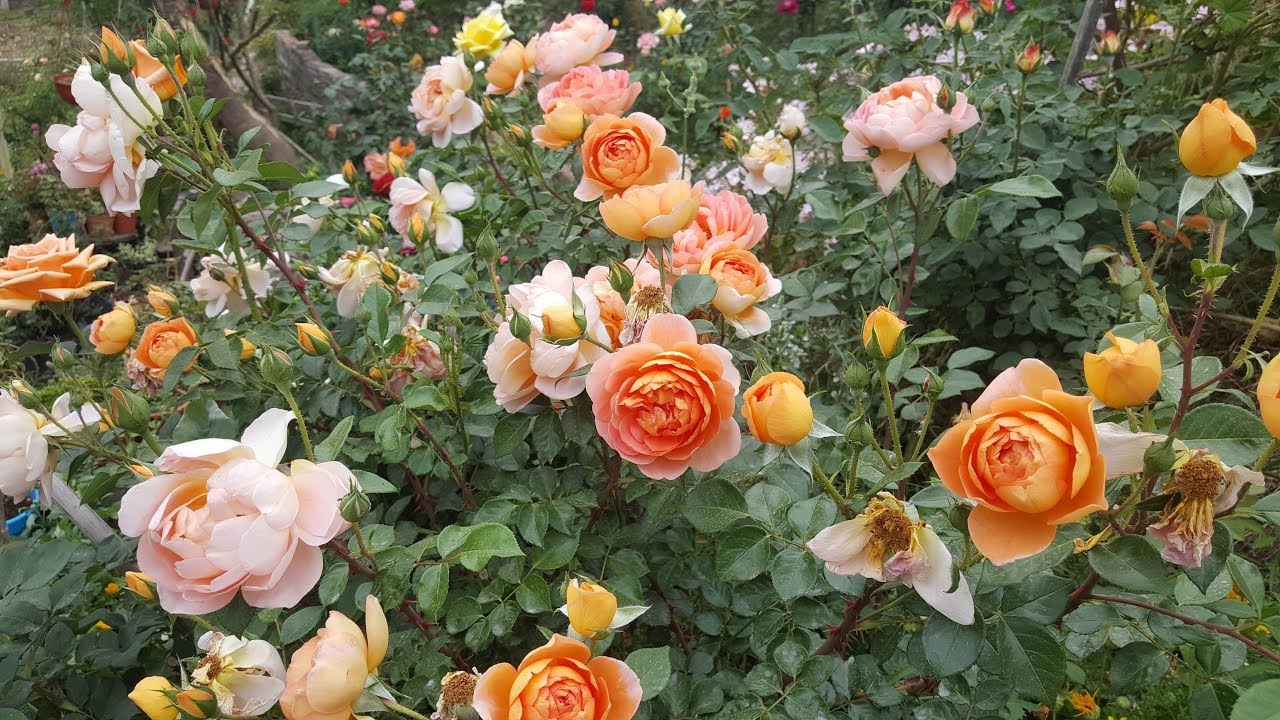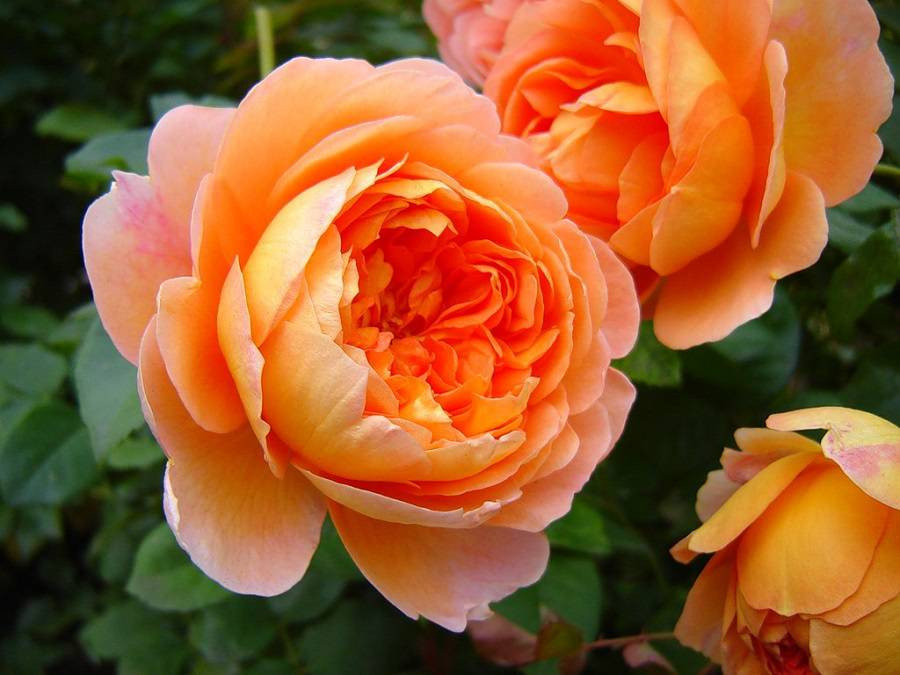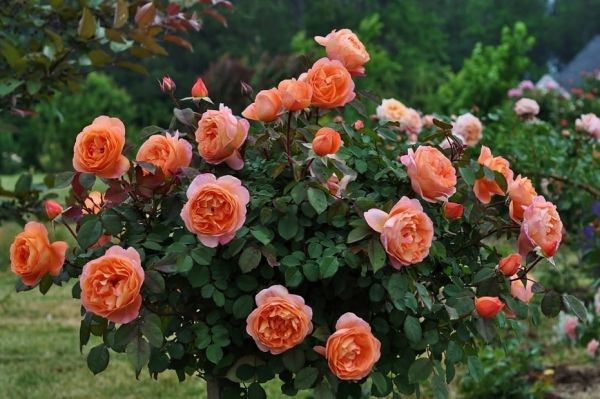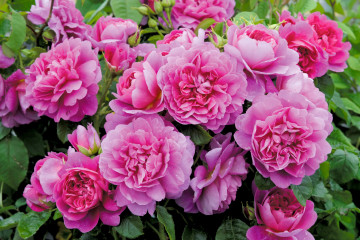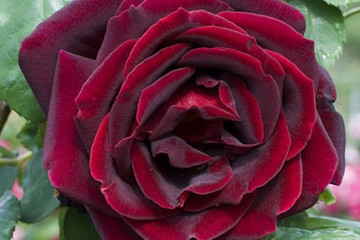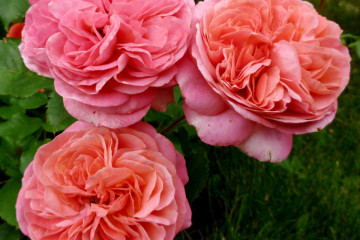Rose Pat Austin (Pat Austin) - variety description
Content:
Breeder David Austin's roses are similar to the old varieties, but are more resistant and almost all bloom again. Due to the peculiar shape of the glass, they stand apart, and do not compete with hybrid tea. But Pat Austin stands out even among English roses - he destroyed the claim that their creator has a special fondness for pastel colors.
Rose Pat Austin (Pat Austin) - what kind of variety, history of creation
Rose Pat Austin is named after David Austin's wife and has become a real gem of his collection. It was created by crossing the famous varieties Graham Thomas and Abraham Derby in 1995. Awarded with the quality mark of the British Royal Horticultural Society (RHS), received awards at numerous exhibitions.
Brief description, characteristic
For David Austin, Pat Austin's rose became a new stage - he moved away from the delicate pastel shades familiar to the collection and created a spectacular flower. The color of the petals is changeable. On the outside, they are bright, copper-yellow, fade to coral as they age. The back is pale yellow, fading to cream.
Pat Austin's buds are double and semi-double. A deep bowl-shaped glass with 50 petals. Most are bent inward, the outer ones are wide open. Due to the structure of the flower, the outer and inner parts of the petals are clearly visible, markedly different in color. This creates an interesting visual effect and makes the rose especially attractive.
Pat Austin flowers are collected in a brush, usually 1-3 pieces, less often - up to 7 buds. The size and lifespan of the glass depends on the external conditions. Its size can be 8-10 or 10-12 cm. The flower does not lose its decorative effect from a day to a week.
Rose Pat Austin forms a sprawling bush with a diameter of 120 cm at a height of about 100 cm. The shoots are weak, they do not cope well with the load of flowers, during the rain they often break or lodge without support. The leaves are dark green, large.
David Austin himself positions the rose scent as pleasant, tea-like, of medium intensity. Russian amateur gardeners often note that the smell can be strong and cloying. Obviously, this is another indicator of the variety's instability.
Advantages and disadvantages of the variety
Pat Austin is scolded as often as he is praised. With the amazing beauty of the glass, the rose is capricious and unpredictable.
Advantages of the variety:
- pleasant strong aroma;
- double flower;
- relative shade tolerance (in comparison with other varieties);
- beautiful glass;
- re-flowering;
- good (for English roses) frost resistance.
Disadvantages of Pat Austin:
- during the rain, the flowers droop and begin to rot, the buds do not open;
- the variety suffers from heat;
- medium resistance to typical rose diseases;
- does not tolerate temperature changes;
- instability - the characteristics of the plant are highly dependent on external conditions;
- the complexity of independent reproduction (like all Ostins).
Use in landscape design
It looks good when planted as a hedge, tapeworm (single focal plant), in the foreground of large landscape groups.
Pat Austin is placed in flower beds and ridges in the company of plants that are radically different in the size and shape of the buds or their color:
- delphiniums;
- daisies;
- lupines;
- sage.
Rose Pat Austin landscape designers recommend planting next to sculptures, gazebos, benches. They will decorate any MAFs (small architectural forms), except for fountains - close proximity to splashing water will negatively affect the flowers.
Growing a flower, how to plant it in open ground
For roses, choose a flat area or with a slope not exceeding 10%. Most of them feel good outdoors. But Pat Austin in the south should be planted under the protection of large shrubs or trees with an openwork crown.
Roses are undemanding to soil, but grow better on slightly acidic, organic-rich loams. They cannot be planted in wetlands.
The variety is intended for cultivation in the sixth zone, where frosts can reach -23 ° C. But David Austin is a well-known reinsurer in terms of the frost resistance of roses. Russian gardeners plant a flower at 5, and cover in the same way as other varieties. Zone 4 will require serious frost protection, but even there Pat Austin feels quite satisfactory during the growing season.
Roses can be planted in spring or autumn. In cooler regions, this is best done at the beginning of the season, when the ground warms up. In the south, autumn planting is preferable - a sudden heat can destroy a bush that did not have time to take root.
Landing order
A bush with an open root system must be soaked for 6 hours or more. Planting pits are prepared at least 2 weeks in advance. Their size should be equal to the size of the earthen coma plus 10-15 cm.The standard diameter of the hole for planting roses:
- on organic-rich loams - 40-50 cm;
- for sandy loam, heavy clay and other problem soils - 60-70 cm.
Chernozem and bulk fertile soil do not need special improvements. In other cases, a planting mixture is prepared from humus, sand, peat, sod land and starting fertilizers. Excessively acidic soil is improved with lime or dolomite flour. Alkaline is brought back to normal with sour (red) peat.
Landing Algorithm:
- The pit is completely filled with water.
- When the liquid is absorbed, a mound of fertile soil is poured in the center.
- A seedling is placed on top so that the grafting site is 3-5 cm below the edge of the pit.
- Spread the roots.
- Carefully fill the hole with fertile soil, constantly compacting it.
- Water the seedling, spending at least 10 liters of water per bush.
- Fill up the soil.
- Repeat watering.
- The bush is spud to a height of 20-25 cm. In a heavily cut rose, only the tips of the shoots are left on the surface.
Plant care
Unlike other roses, Pat Austin is quite demanding to care for. It needs to be watered rarely, but abundantly, spending at least 10-15 liters of water under a bush at a time. It is desirable to keep the air humidity high, but fogging installations and the close location of fountains will negatively affect flowering. It is good if there is a flower bed nearby with plants requiring abundant watering. This will help maintain the required air humidity.
Pat Austin is fed at least four times per season:
- early spring with nitrogen fertilizers;
- during the formation of buds, a complete mineral complex with trace elements;
- the same top dressing is given to the rose when the first wave of flowering subsides;
- in late summer or early autumn, the bush needs phosphorus-potassium fertilizer - it will help the plant overwinter and strengthen weak shoots.
Experienced gardeners advise to prune Pat Austin only in the spring, before the buds open:
- if they want to form a bush like a shrub, remove dry, broken, frozen, shading, thickening branches and shoot tips on the outer bud;
- those who do not like drooping lashes weighed down with flowers make a short pruning.
In zones of frost resistance, including the 5th, Pat Austin is covered for the winter, like other roses - a mound 20-25 cm high is poured around the bush. The fourth zone requires more serious protection with spruce branches and white non-woven material.
Blooming rose
Rose Pat Austin is one of the first to bloom. With proper care and sufficient feeding in the Middle Lane, the buds cover the bush from mid-June until frost.
For flowers to appear continuously, you need:
- remove the buds immediately after the loss of decorativeness, without waiting for the petals to completely fly around;
- monitor the health of the bush;
- abundantly, but rarely water;
- feed roses;
- mulch the trunk circle with humus or peat.
In addition to non-compliance with the listed requirements, flowering is negatively affected by:
- temperature changes;
- with heat above 35 ° C, the buds may not open at all, the flowers quickly age and crumble;
- too shaded placement of the plant in cool regions, or sunny without cover - in the south;
- the rains spoil the blooming roses, and the buds are not allowed to bloom.
Flower propagation
It is unlikely that amateur gardeners will be able to propagate the Pat Austin rose on their own. Cuttings do not take root well, and even if they take root, they often die in the first 1-2 years.
Seed propagation of roses is interesting only to breeders. Varietal traits are not inherited with it.
Pat Austin and other English roses are predominantly propagated by grafts. However, this method is available to specialists and gardeners with extensive experience.
Diseases, pests and ways to control them
Rose Pat Austin has an average resistance to typical diseases of the culture:
- powdery mildew;
- black spot.
It is affected by pests in the same way as other varieties. The most common:
- spider mite;
- aphid;
- leaf roll;
- shield;
- slobbering penny;
- bear.
Fungicides are used to treat diseases. To cope with pests, they use insecticides, attract birds and beneficial insects to the site.
Rose Pat Austin is very beautiful. It is loved by the owners and landscape designers, but the variety is a lot of trouble for gardeners. It is worth growing a rose only if it is possible to provide competent, constant care.

